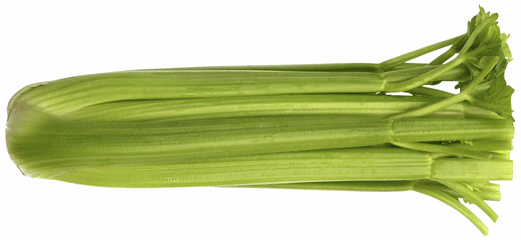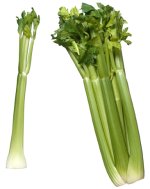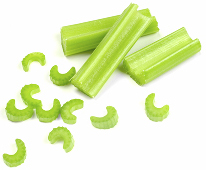

Celery

Apium graveloens variety dulce. Umbelliferae. A biennial, generally grown as an annual for its crisp, fleshy leaf petioles, which are popular as a salad crop. It is a native of Europe and Asia, where wild forms occur in damp or marshy areas. It has been cultivated for over 2000 years and is grown widely in temperate regions, particularly in Europe and North America. In tropical regions successful cultivation is only possible at high elevations. Celery grows best at mean monthly temperatures in the range 16-21ºC, above which leaf growth is poor. Lower temperatures will induce bolting, although this depends to some extent on plant size and cultivar. Typically plants with five or more true leaves will flower following exposure to temperatures between 5-10ºC for 10 days or more. The main cropping season is from summer through autumn until the first occurrence of winter frosts. The growing season may be extended under protection. Grow on a sunny site in a well-drained but moisture-retentive soil. The addition of well-rotted organic matter may be necessary to increase the water-holding capacity of lighter-textured soils. Soil pH should be between 6.6-6.8. Traditionally, celery was blanched by growing in trenches and later earthing-up to exclude light from the developing petioles. Under this system the ideal soils were peaty organic ones. Self-blanching celery is now more widely grown and can be cultivated on a much wider range of soil types. As the root system is relatively shallow, plants must be kept well supplied with both water and nutrients throughout their development. Propagate from seed, which is small and often exhibits erratic germination. Direct sowings are rarely successful and the crop should be established from transplants. Young plants should be raised in the glasshouse at about 15ºC. Thin out the seedlings into trays with 5cm between plants. They should remain in the glasshouse until well established, before hardening off and planting out in late spring or early summer. Self-blanching celery should be planted at high density (25 x25cm) to aid blanching. Non-blanching cultivars should be planted in widely spaced (90cm) single rows at a within-row spacing of about 25cm, to enable the plants to be earthed up when approximately 30-35cm tall. Modern green cultivars should be grown in a similar manner to the self-blanching types. All types must be well watered to produce succulent petioles. Harvest well-developed plants by cutting them at ground level. Harvesting can continue until the first frosts cause damage, but can be extended into the winter by protecting plants with an insulating layer of straw and covering with opaque (preferably white) polythene. 
Cultivars vary broadly divided into trenching types, which are either white or tinged pink to red, and less hardy and milder-flavoured self-blanching white or green kinds. Recommended cultivars of the first group include ‘Florida 683’, ‘Giant Red’ (dark red or purple tinged), ‘Hopkins Fenlander’, ‘Frosty Tower’ (exeptionally long), ‘Solid White’, ‘Unrivalled Pink’ and ‘Utah 52-70’. Of the more widely grown self-blanching types, ‘Lathom Self-Blanching’ is resistant to bolting. The best-known of the green cultivars is ‘American Green’; others are ‘Celebrity’ and ‘Triumph’. ‘Golden Plume’ and ‘Golden Self-Blanching’ have yellow sticks. Pests include slugs, celery leaf miner, carrot fly and celery fly. The most important disease, septoria leaf spot (late blight), is seed borne; seed offered by reliable seed merchants will be either substantially free from the disease or will have been treated with fungicide. Other significant diseases include aster yellows, bacterial soft rot, cercospora leaf spot (early blight), especially in the US, damping off, Sclerotinia (pink) rot, fusarium wilt, which is serious in the northern US, and a range of viruses including celery mosaic virus.
|
Home
Grow Nuts
Grow Herbs
Grow Fruit
Cyberian Index
If you like this website and want one of your own contact
Cyberian All information correct at
time of publication and open to updates as necessary. No part of this website,
or its vectors, may be produced in any shape or form, using any type or design
of medium, system, equipment or otherwise without the prior written consensual
notice of the Cyberian. Any breach of these requirements will result in the
appropriate action. If in doubt, e-mail contact is recommended.
Some components of this website were obtained as open-source software and are
used in the same non-profit manner on this website.